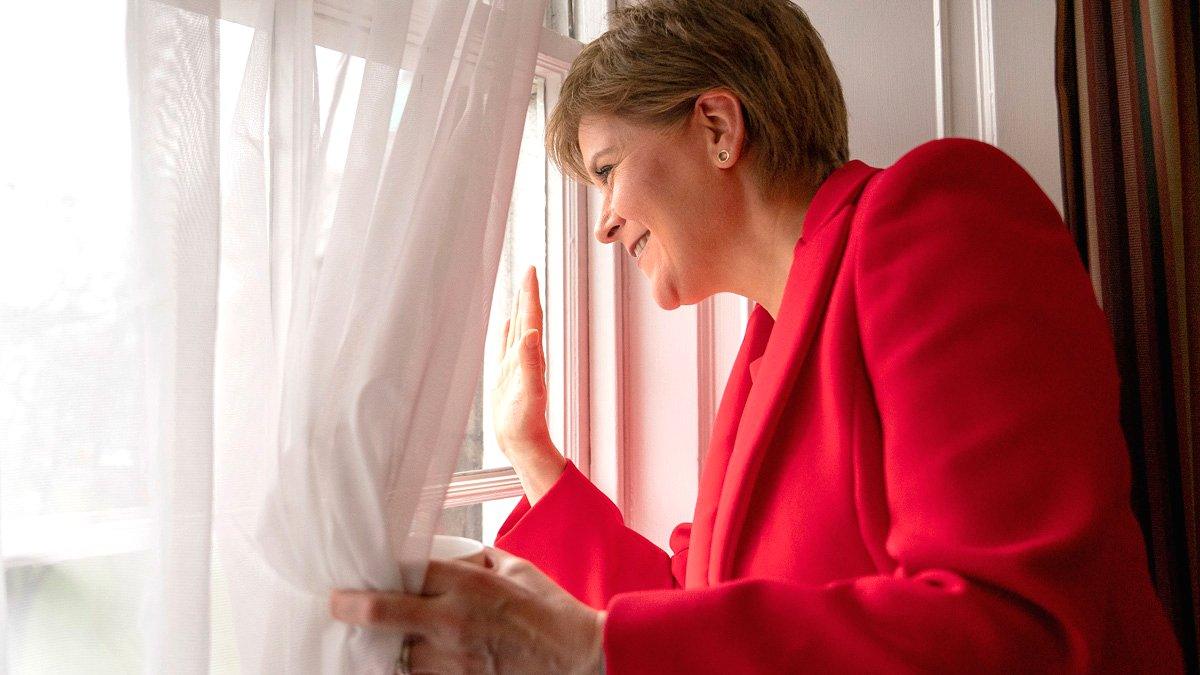Scottish independence: How did we get here and what happens next?
- Published
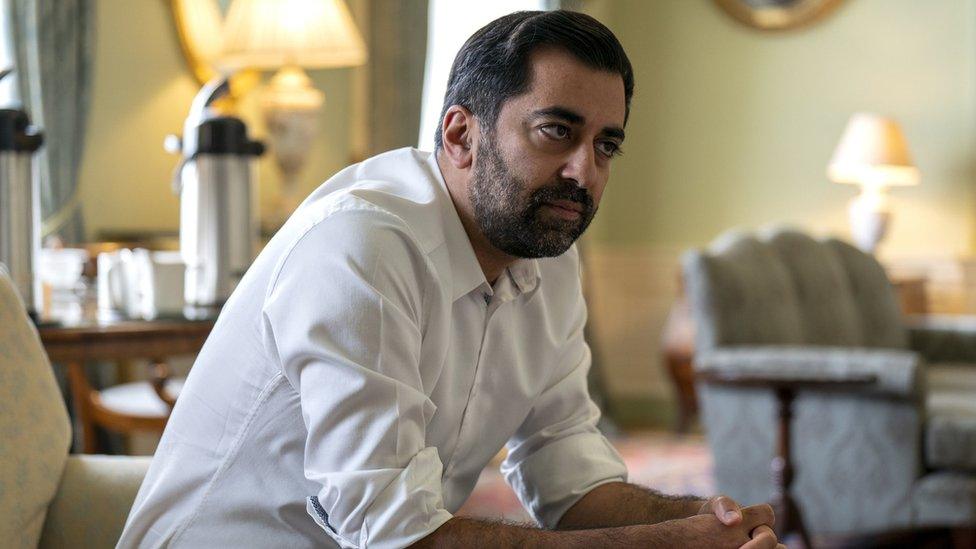
Almost a decade on from the 2014 referendum, the SNP are going back to the drawing board in their bid to secure Scottish independence.
Humza Yousaf says the next general election should be used to give him a mandate for independence negotiations.
If the SNP wins the most of the seats in Scotland, he proposes the Scottish government should seek talks with the UK government.
The first minister hopes the strategy will win the support of SNP members at the party's conference in Aberdeen this weekend - and interrupt years of intransigence from Conservative UK governments.
Here is a reminder of how Scotland got to this latest constitutional waypoint.
Independence referendum
The route to the 2014 independence referendum was opened in May 2007, when the SNP won the Scottish Parliament election, taking one more seat than Labour and forming a minority government.
The plans progressed after the SNP stormed to victory in the 2011 election, forming a majority government.
The Edinburgh Agreement, signed by Alex Salmond and David Cameron, paved the way for the ballot.
A Section 30 Order - a mechanism at the centre of future constitutional battles between Holyrood and Westminster - was granted to allow the Scottish Parliament the powers to hold a referendum on 18 September 2014.
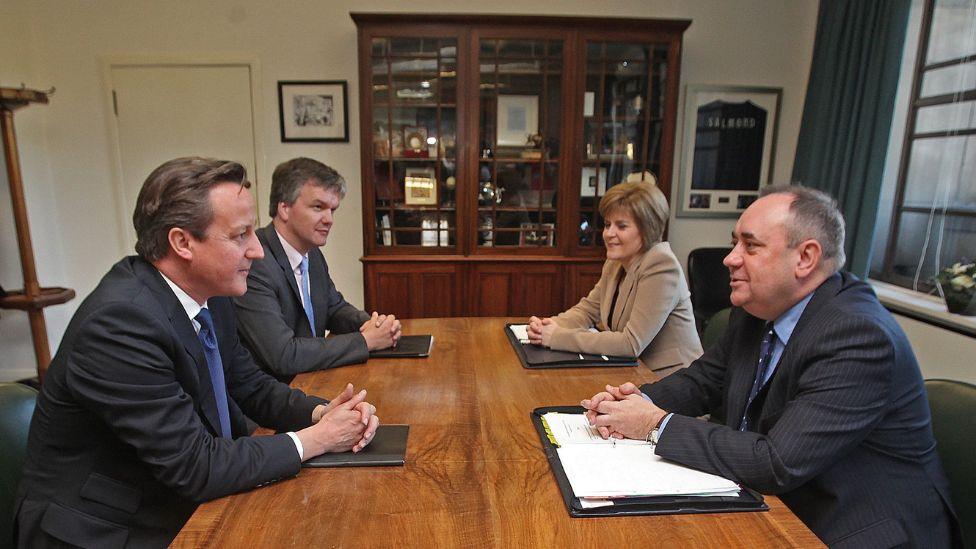
The Edinburgh Agreement paved the way for the 2014 vote
Optimism on the Yes side peaked in the weeks leading up to the vote, with polls in the Sunday Telegraph and Sunday Times recording narrow pro-independence majorities - up from about 30% support at the start of the campaign.
But the unionist campaign ultimately prevailed, winning 55% of the vote compared with 45% for Yes.
The result led to the resignation of first minister Alex Salmond, who was succeeded by Nicola Sturgeon.
Brexit shock
According to successive Conservative prime ministers, 2014 settled the matter. Yet the constitutional debate has raged on.
The shock result of the June 2016 Brexit referendum brought renewed vigour and urgency to the independence movement - as well as fresh practical questions about how a pro-EU independent Scotland could deal with other parts of the UK while they remained outside the bloc.
Scotland voted overwhelmingly to remain, by 62% to 38%, while the UK overall voted to leave by 52% to 48%.
In its manifesto for the previous month's Holyrood elections, the SNP said the Scottish Parliament should have the right to hold another referendum if there was a "significant and material change" in the circumstances at the time of the 2014 referendum, such as Scotland being taken out of the EU against its will.
Ms Sturgeon said the result made a second independence referendum "highly likely", describing Brexit as "democratically unacceptable" for Scotland.
She had warned of Brexit, external in the lead up to the 2014 referendum, and said Boris Johnson could be the prime minister when it happens.
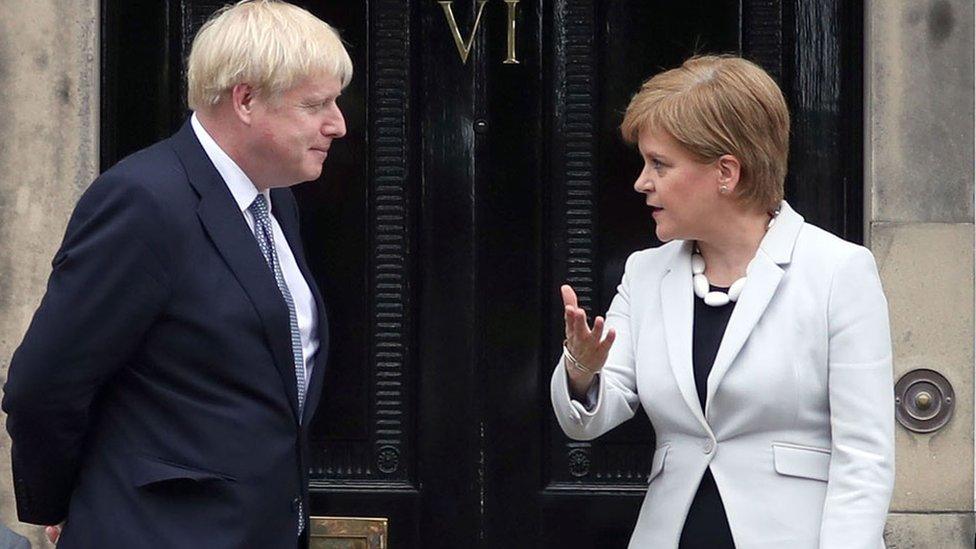
Boris Johnson dismissed Nicola Sturgeon's call for negotiations over a second referendum
In time Ms Sturgeon was proved right, with Mr Johnson taking over from Theresa May in July 2019 before winning a thumping Conservative majority in December.
His considerable unpopularity in Scotland and the fraught Brexit debate coincided with several years of unprecedented electoral success for the SNP under Ms Sturgeon.
Support for independence manifested in mass marches and rallies for independence. After tens of thousands took to the street of Edinburgh in October 2019, Ms Sturgeon tweeted, external: "Be in no doubt - independence is coming."
Brexit became, and has remained, the key fault line in the independence debate, with a majority of those in favour of EU membership also in favour of independence.
In May 2019, Ms Sturgeon earmarked the second half of 2020 for a second vote on the constitution.
Yet in the face of steadfast opposition from Westminster, the momentum did not translate into concrete action towards an independence referendum - to the growing frustration of some within the Yes movement.
Covid crisis
The turmoil of Brexit was soon overshadowed by the explosion of Covid-19 cases across the world in early 2020.
Ms Sturgeon's role was transformed, with Scots tuning in daily to grim health briefings providing death tolls and announcements on new restrictions on everyday life.
Plans for an independence referendum in 2020 were "paused", but support for Yes swelled. Between June 2020 and January 2021, support for independence was consistently ahead, external in the polls.
The chaotic reign of Mr Johnson at Downing Street, punctuated by scandals involving chief aide Dominic Cummings, ensured Ms Sturgeon's more measured approach compared favourable in the eyes of Scots.
In May 2021, the SNP and Greens secured a pro-independence majority at the Scottish Parliament election.
Alba, set up by former first minister Mr Salmond, had aimed to build "a supermajority for independence" but failed to win a single seat at Holyrood.
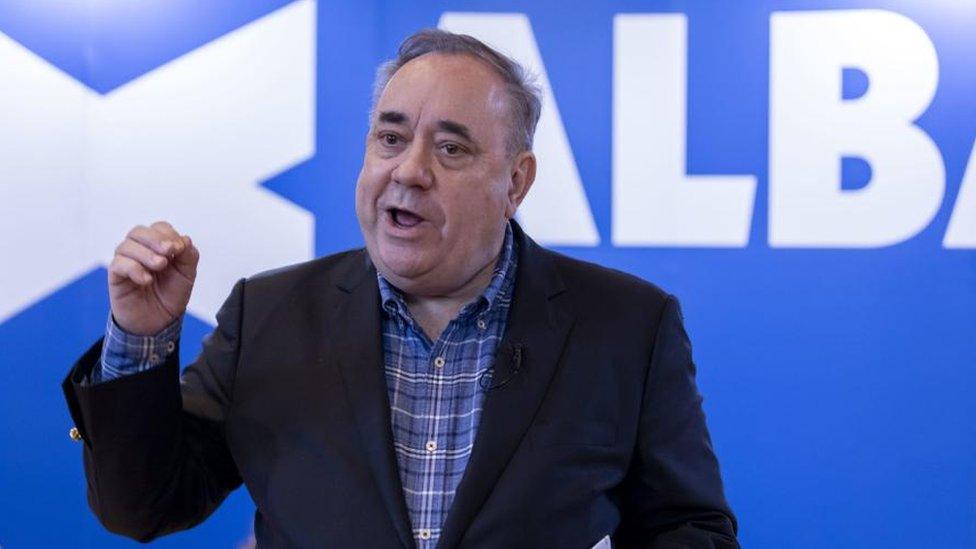
Alex Salmond set up Alba in the lead up to the 2021 election
It came after a long-running public dispute between Mr Salmond and the Scottish government over the handling of harassment complaints against him.
Coinciding with heated debates on gender recognition reform and the best route to securing independence, it helped splinter the Yes movement.
By September, indyref2 was back on the table. Ms Sturgeon said while Covid "continued to be the priority", it was right that the country's future would be "decided by people in Scotland" once the crisis was over.
The UK government remained unmoved, refusing to recognise the Scottish government's democratic mandate.
It said the referendum should be "once in a generation" and that the focus should be on recovering from the pandemic.
Sturgeon names a date
In June last year, Ms Sturgeon proposed 19 October 2023 as the date for a second referendum.
She told MPSs that any vote would need to be "indisputably lawful" and constitutional. She said the Supreme Court would be asked to rule on whether the Scottish government has the power to hold a vote without UK government approval.
In one of his last acts before resigning as prime minister, Mr Johnson told Ms Sturgeon that it was "not the time" to hold a referendum.
In November 2022, the Supreme Court ruled that the Scottish government could not hold an independence referendum without the UK government's consent.
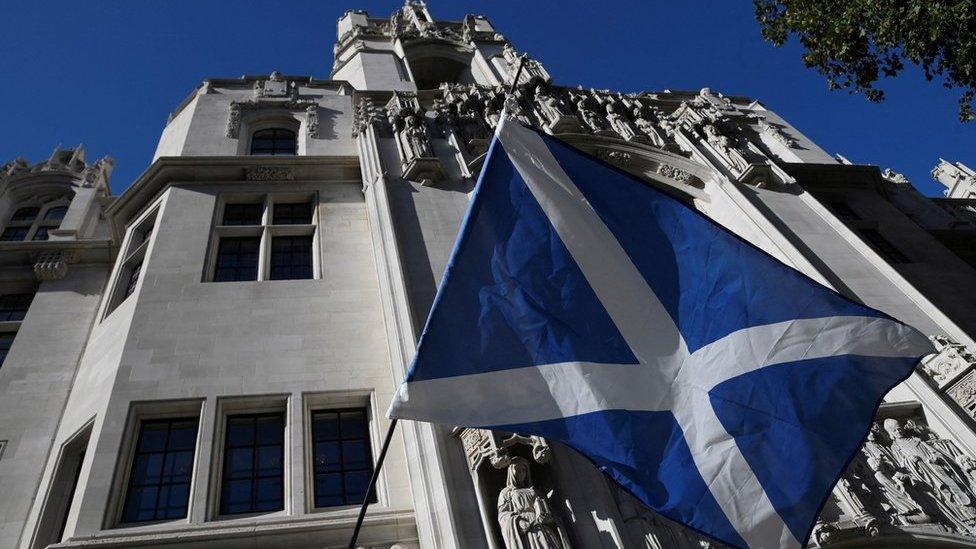
The Supreme Court ruled against the Scottish government
It was a major, if not wholly unexpected, blow to the Scottish government's independence strategy, forcing ministers to announce a plan B.
However, it did lead to brief spike in support for Yes in the polls.
Ms Sturgeon said she wanted to fight the next general election as a de facto referendum before announcing a special conference on independence to "discuss and decide the way forward to secure independence".
A new first minister
The dispute with Mr Salmond, the Covid crisis and questions over SNP finances had all chipped away at Ms Sturgeon's once iron-clad standing in Scottish politics.
In February 2023, she announced she would resign, raising fresh concerns over the future of the Yes movement, with support steadying at about 48%, external since the Supreme Court decision.
She was succeeded by loyal minister Humza Yousaf, who has sought to put his own stamp on the independence strategy.
In the proposal to party members to be debated this weekend, he said the government will seek independence negotiations with Westminster if the SNP wins the most seats in Scotland at the next general election.
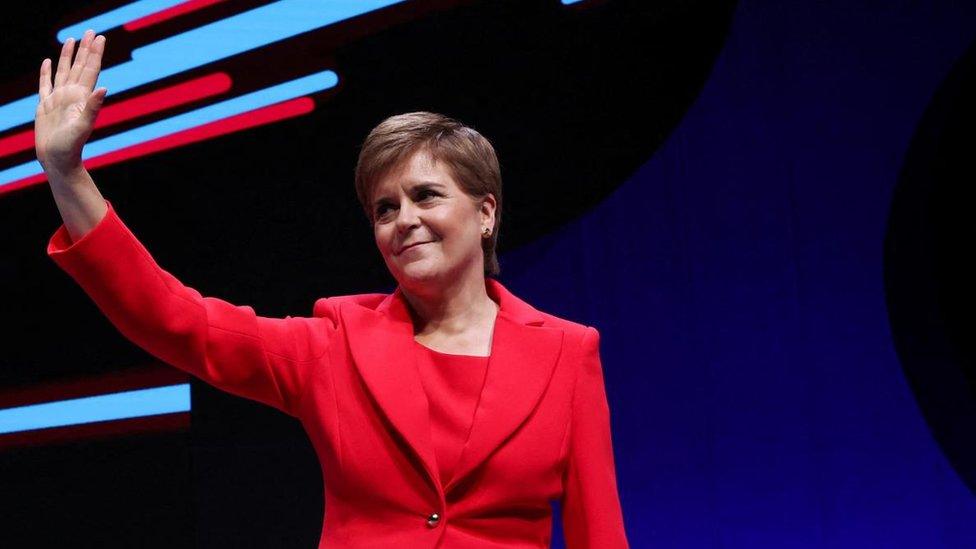
Nicola Sturgeon resigned as first minister in March 2023
The motion, also signed by SNP Westminster leader Stephen Flynn, proposes making the first line of the manifesto: "Vote SNP for Scotland to become an independent country."
The text states that if the party wins the most seats, the Scottish government will be "empowered to begin immediate negotiations with the UK government to give democratic effect to Scotland becoming an independent country".
High-profile SNP politicians, however, have tabled alternative plans - including proposals based on winning the most votes at a general election or using the 2026 Holyrood election as a de facto vote.
The way forward may not be clear, but the constitutional debate seems bound to rumble on.
- Published29 April 2023
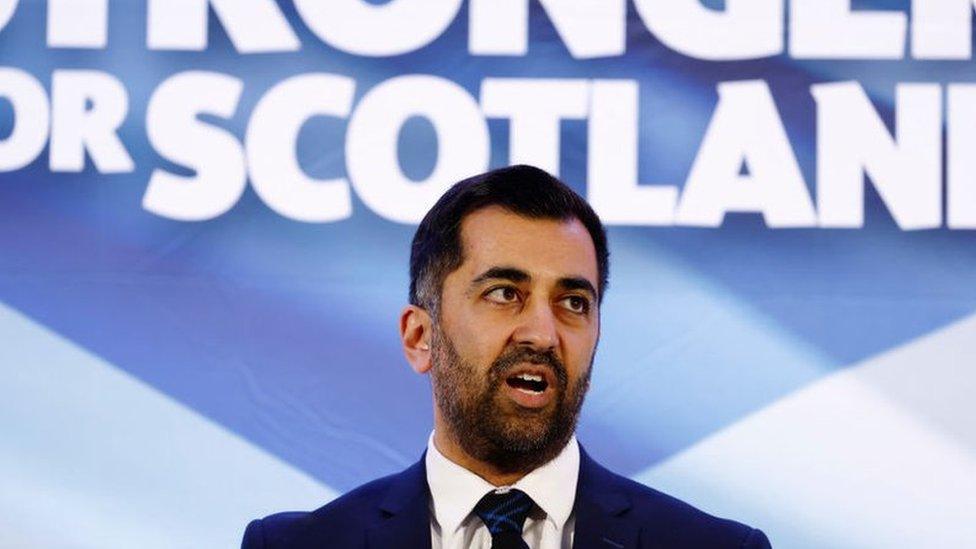
- Published26 February 2023
